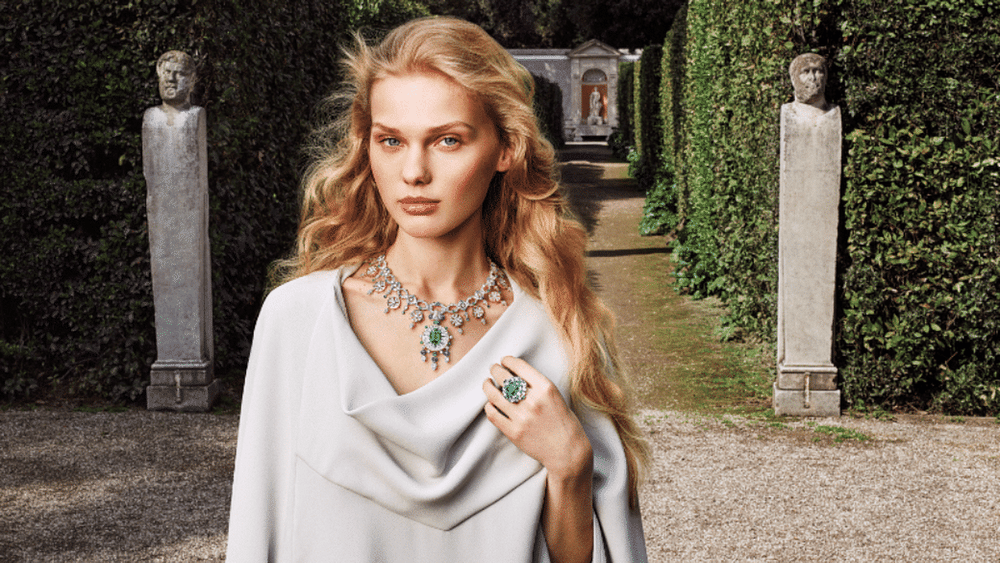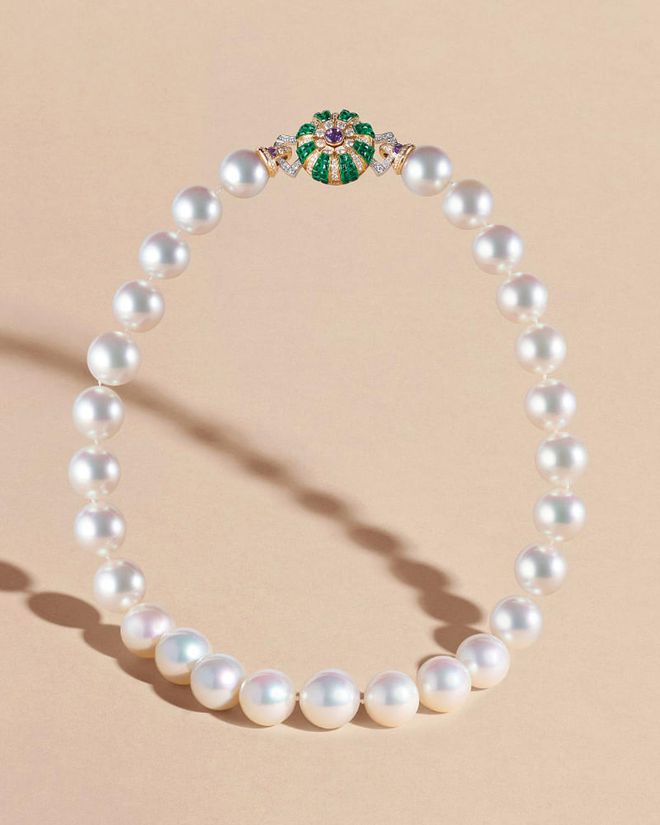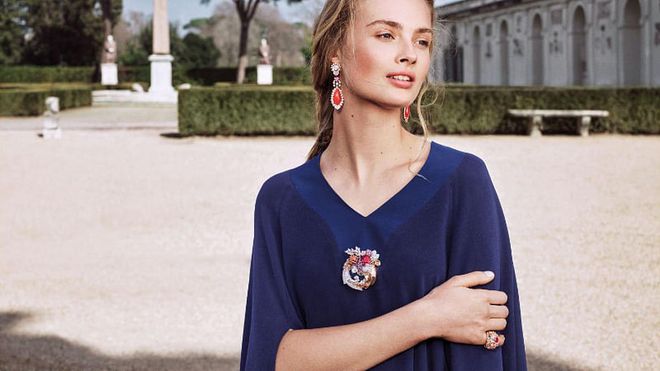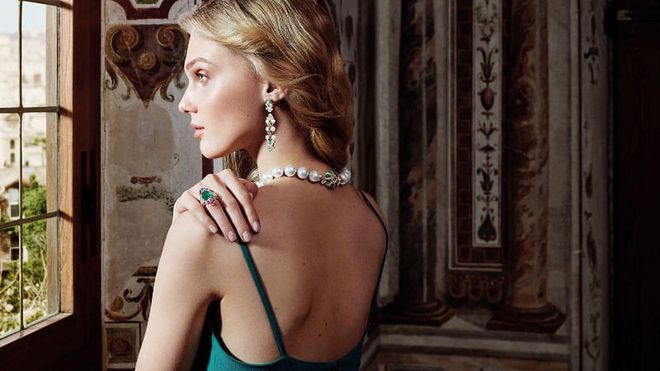EIC Kenneth Goh Reports On Van Cleef & Arpels' Le Grand Tour High Jewellery Collection From Rome
Editor-in-Chief Kenneth Goh spoke to Van Cleef & Arpels' CEO Nicolas Bos on his highlights from the Le Grand Tour high jewellery collection.


Éclat Mystérieux necklace.
I’m seated in the beautiful gardens and maze of the Villa Medici in Rome, sipping a glass of bubbly in the shade of the evening sun. The sky is sparkling blue, the sandy walkway golden and warm to the touch—heated during the day by brilliant sunshine that only seems to get hotter by the minute in this Eternal City. I imagine myself as one of the gentlemen described vividly by Nicolas Bos, CEO of Van Cleef & Arpels. Invited by him to experience the wonders of their high jewellery collection, named Le Grand Tour, Bos describes a rite of passage for many young men in the old world as “a very important journey in Europe in the 18th and 19th century.”
Related article: Travel The World With Van Cleef & Arpels’ New ‘Le Grand Tour’ High Jewellery Collection
These young artists and creators would often start the Grand Tour from London or Paris or Germany, and would traipse across Europe, visit Switzerland and the Alps, to discover the marvels of nature, art and culture. Italy was the main destination of the tour, which included beloved cities like Venice, Naples and Florence.
Here, in the gardens of the Villa Medici, I'm treated to a little hint of these places. Amazing set-ups with hot-air balloons to scenes of lovers seranading to each other in operatic Latin. In Bos’ words, it is this journey that inspired “our designers, craftsmen and store experts to create a collection that would pay tribute to the beautiful idea of travelling for arts and education.” Bos adds, “I love the idea that even sometimes, when we don’t know what the grand tour is about, when we talk about tourism, it is actually coming from the grand tour, and this is just a way to talk about it.”
The Villa is at the heart of the Grand Tour as it has been the French Academy of Art in Rome since 1666. While the Grand Tour was not created here originally, but in a different place, it was the place to welcome French artists to Rome so that they could discover the city and all the works of art that, at the time, were not organised in museums. It was here in Rome that the artists stayed, formed their taste, and painted, before returning to their cities more educated, and more inspired.
And this is a story that continues today. For Bos, the Villa “is not only a fantastic memory of the past and celebration of beauty of the Italian Renaissance, but a celebration of living art and creation.”
To get an in-depth idea of the celebration of the Grand Tour and how the collection was created, Bos shares with me some of his highlights from Le Grand Tour.
Related article: The Latest And Most Talked About Jewellery Collections

Fleuve De Glace transformable long necklace.
How did it all start? What was the inspiration and the starting point?
“This idea of the grand tour is from the celebration of travel that has always been key in the creative arts. And for Van Cleef & Arpels, many of our collections are dedicated to travel to Egypt, India and even Persia. It’s always this idea of paying tribute to other civilisations, Eastern cultures and trying to give an interpretation of French history. The Grand Tour was always fascinating to me because it was a very important phenomenon in Europe in the 1870s. The 18th century has been extremely influential, but in general, widely forgotten— perhaps a bit better known in Italy and in the UK—but really forgotten in France. A lot of things came from that phenomenon, such as travel guides. Perhaps you can call it tourism because the tourists were the people that were doing the grand tour. So the more I learnt about it and started to work with the team, the more we thought it was an interesting starting point for a collection that would be dedicated to travel within Europe. Through this angle of the grand tour, you would see Europe through their eyes, how they took references of the paintings, poetry and beautiful stories. So that was how we started to build the collection, to draw the pieces, but also to look for certain stones, to try to identify techniques that would be appropriate. And then we always try in everything that we do to keep the whole consistency of the story.”
Related article: Stack Attack: How To Stack Your Bracelets And Watches Effortlessly

Carriera earrings with detachable pendants; Jeu De Colombage transformable ring.
Were there any rare pieces from the archives that you wanted to show? I noticed there were three stones on brooches that were old pieces that have been changed in their design and their original intent. Was there a certain type of inspiration that you wanted to bring out from the archives?
“One specifically. We did some engraving techniques on gold that were in use in the ’70s on the brooches with the trees in the Baden-Baden section. One of my favourite pieces are the bracelets that are fashioned like landscapes. It’s something that you did in the 1920s with Egyptian-inspired jewellery. Then about 15 years ago we did a collection on the California landscape. So we revived this technique of creating a landscape on these four bracelets. It’s truly a culmination of many elements coming from a lot of different pieces and eras from our rich history. What we’ve developed today is really an improvement from the original Egyptian bracelet because we’ve redeveloped the whole connection system at the back of the bracelet so that it doesn’t create any gaps, no matter what angle you look at it from.”

Éclat Mystérieux necklace; Elizabeth earrings with detachable pendants; Cornucopia clip; Schappel ring.
Related article: 15 Statement Earrings That Bring The Wow Factor
How were the gems selected for each piece? And where did you place that gem within the Grand Tour collection?
“It’s a mix of different things. Each city has its own set of colours. So that’s going to dictate the usage of certain stones. And each city has its own spirit. So Rome is a bit more antique. Baden-Baden has something a bit more wild and natural. Here, we wanted to include these very big stones like opals or coral with the set of rubies, which is an extraordinary, perfectly paired marriage. Venice, with its structure of palaces, bridges and arches creates very regular forms. So we included the regularity of the rubies, whereas there are some pieces where you want to put more attention to the asymmetry. So there are no strict rules, but certain things kind of fall into place for a reason in general.”